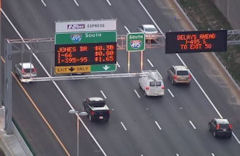495 Express Lanes has increased the speed limit on the I-495 express lanes in Northern Virginia from 55 miles per hour to 65, giving riders a significant new time-saving inducement to use the tolled lanes. The change took effect after the Virginia Department of Transportation released a study confirming that raising the speed limit would not pose a safety problem.
Transurban, the operating partner, opened the express lanes in November with a 55 mph limit to identify possible safety issues, with the expectation that the speed limit eventually would increase to 65 mph. After operating the express lanes for half a year, Transurban sent its safety data to VDOT, which voiced no significant concerns.
Though not a surprise, the change is nonetheless good news for 495 Express Lanes, which is in the midst of a multi-year ramp-up to build traffic to profitable levels. The company prices tolls dynamically, depending upon traffic conditions, in order to ensure speeds of at least 45 mph during congested periods. The higher speed limit will provide motorists a reason to use the express lanes during periods of lighter traffic and free-flow conditions, where they will enjoy a 10 mph speed advantage over the mainline lanes.
Nationally, express lane revenues have brought in revenue less than anticipated since the recession, as Americans have driven less. (See “Dude, Where’re My Cars?” as well as this recent post on the Atlantic Cities blog.) Forecasting traffic volumes can be a hazardous business, as Transurban learned from its experience with the Pocahontas Parkway outside Richmond. When revenues for that toll road fell short of projections, the company took a $181 million write-off and sold its interest to a consortium of European banks.
The Pocahontas Parkway traffic was contingent upon traffic materializing from major real estate development projects that never transpired. Traffic volume along the Capital Beltway, by contrast, was a known quantity. Even so, there was a question how much Washingtonians would be willing to pay to avoid congestion.
The new lanes opened in November. Four months later, in February, Transurban’s Peirce Coffee conceded to Washington’ Channel 8 television station: “Traffic is a little bit below expectations.”
In April, Transurban rolled out free weekend access to the express lanes in order to introduce people to the facility. Thousands of drivers — four times the normal weekend volume — responded, says Transurban spokesman Mike McGurk. “People definitely took advantage of it.” Company officials hoped that the free weekend would be reflected in a bump in E-Z Pass transponder sales but McGurk said he did not know if that bump materialized.
VDOT’s validation that the express lanes are safe is a positive for 495 Express Lanes. The tolled lanes experienced 51 crashes between November 2o12, when they opened, and April 2013 — an average of two a week. “It is important to note that a majority of the crashes originate in the general purpose lanes and spill across the channelizing posts into the Express Lanes,” states the VDOT report. “It is also important to note that the 485 Express Lanes is a new facility and drivers require time to familiarize themselves with the access opportunities. … Aside from the first two weeks, the 495 Express Lanes have not experienced trouble spots where there are frequent accidents.”
One safety advantage of the express lanes, noted VDOT, is a prohibition against heavy trucks. Another is the fact that there are only two lanes, as opposed to four in the general purpose lanes, meaning “there is no potential for two vehicles moving into the same lane from different directions at the same time.” Moreover, the express lanes are priced to reduce congestion, a risk factor for crashes.
Higher speed limits give motorists yet another reason to use the express lanes. The central question is whether drivers — even affluent, Washington-area drivers — place a sufficient premium on their time to warrant paying to achieve faster, more predictable travel times.
“HOT lanes are a brand new concept,” says McGurk. “It’s such a significant change, we understand there’s a learning curve there.” People can’t just say, hey, I’ll give the express lanes a spin today. They have to obtain an E-Z Pass first. They also have to familiarize themselves with the exit locations and new traffic patterns. “The good thing for us, looking at our traffic and revenue reports,” he continues, “is that we have seen an increase from the early days. We hope more people will recognize this is a great option to have.”



